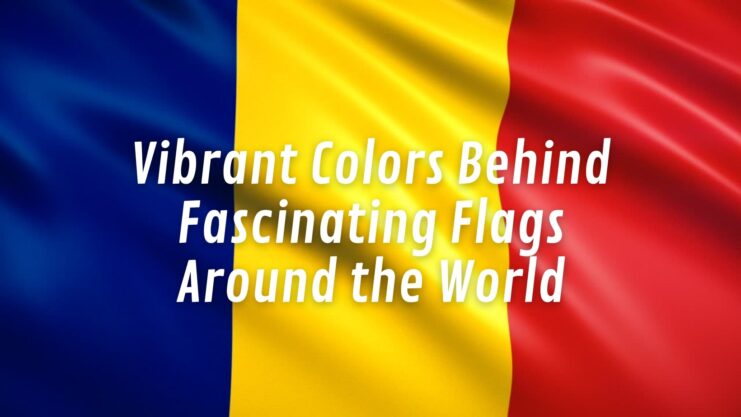They are the symbols that represent countries, states, or provinces. They carry great symbolic value and importance, acting as a representation of the people who live there and the land itself. Throughout history, they have taken many forms and colors, but a few colors have become especially popular among nations. The colors yellow, blue, and red often appear in national flags throughout the world – for instance, Andorra’s flag features all three colors, while Chad has only yellow and blue.
This article will take a look at 8 unique flags featuring yellow, blue and red – from Andorra to Liechtenstein – highlighting their history and symbolism. We will review each one in detail examining the symbolism behind each coat of arms or emblem used. Read on to learn more about these fascinating flags from around the world!
1. Andorra
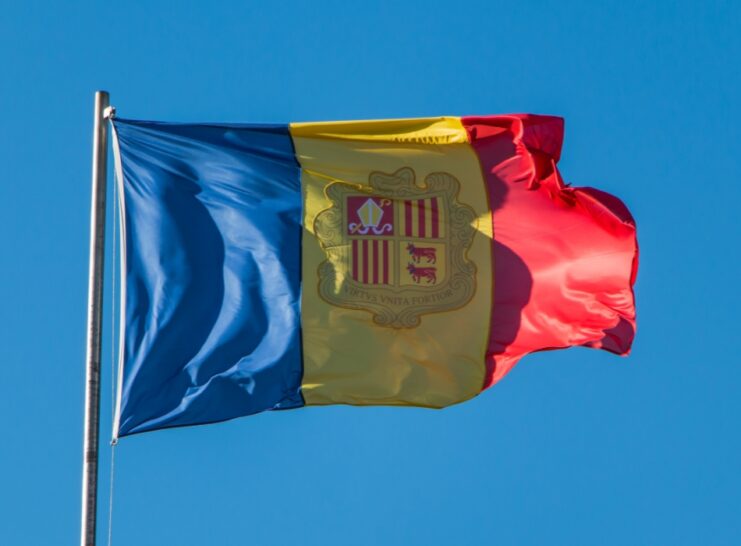
Andorra is a small sovereign principality with a population of about 77,000 citizens. It consists of three vertical stripes of yellow, blue, and red. This design is a combination of the flags of France and Spain, two of its most powerful allies.
The yellow represents the Spanish Crown and the blue and red represent the French flag. The yellow also carries the symbolism of prosperity, while the red represents courage and the blue stands for loyalty.
Flag Description
A tiny independent principality tucked away in the mountains between Spain and France, features a tricolor of equal-sized vertical red, yellow and blue stripes. Additionally, a coat of arms featuring four red quarters with the national heraldic symbols of Andorra is overlaid in the middle.
The colors on it are intended to reflect the country’s culture and its Roman Catholic devotion – with red representing bloodshed through martyrdom during religious wars, yellow representing faith in God and Monarchy, and blue representing peace. The national motto Virtus Unita Fortior translates to “United Virtue is Stronger” in Latin – a nod to its unique political dualism. All these colors together make for an interesting combination on this beautiful flag that has been around since 1806.
Making of the flag
It is a tricolor consisting of horizontal bands of yellow (top), blue, and red with the national coat of arms superimposed in the center. This design has been the country’s flag since 1866. The colors and coat of arms have strong links to Andorra history and culture.
The yellow on it is derived from Catalonia’s Senyera which dates back to 1192, and it is likely that this design was chosen because Catalonia had strong ties to Andorra at that time. The blue on it is meant to represent peace throughout all generations, while red symbolizes brave warriors who defended their country over many centuries.
Finally, the national coat of arms appearing in the middle may have its roots in an ancient banner belonging to Charlemagne during his invasion of Spain by depicting four military banners encircling a star or flower. The colors and descriptions used today remain largely unchanged.
2. Chad
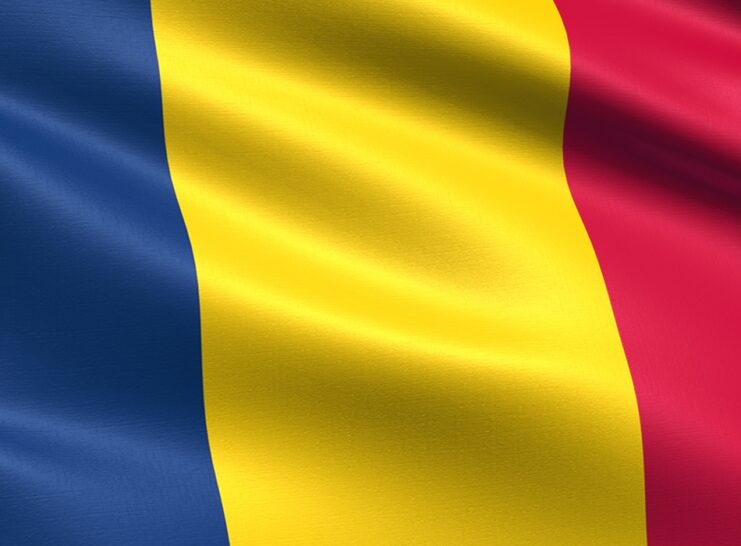
Chad has a bright and attractive flag that stands out due to its yellow, blue and red colors. It is often seen representing the country in international sports and as a show of solidarity with its people.
The colors and elements of it tell a story of the culture, history and values of the country of Chad. Let’s take a closer look at it, its colors and the meaning behind it.
What it represents
It features three horizontal stripes in two distinct shades of blue, alternating with two shades of yellow. The topmost and bottommost stripes are both light blue, while the middle stripe is a darker navy blue. The two yellow stripes are equal in width and separated by lighter shades of blue.
Lastly, at the right-hand side of the center stripe is a large red triangle with its point touching the hoist side edge. This triangle contains a yellow star in its center, which represents solidarity and hope for a better future.
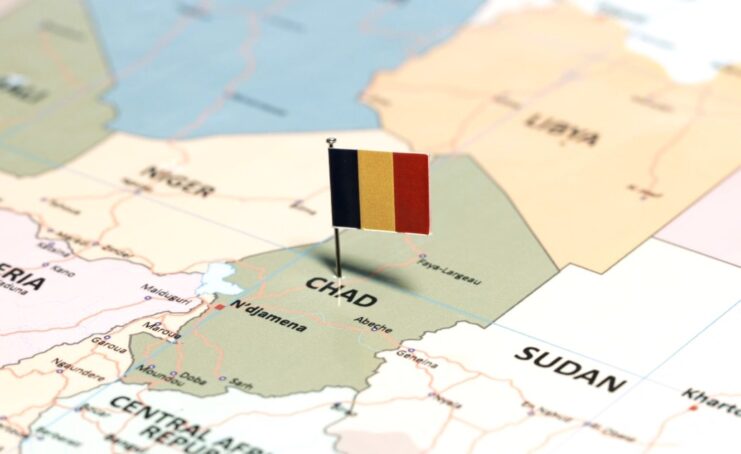
History
It was officially adopted on November 6, 1959. It consists of a vertical tricolor of blue, yellow, and red with a non-circular charge in its center. The original design of the flag was modified twice in 1899 and 2017 to include some differences in shade.
The colors are a symbolic representation of the geographic location and state ideology. The blue stands for the southern part of the country which is host to most natural resources, while the yellow symbolizes the Saharan desert located in northern Chad. Lastly, red inside the entireness circle positioned at the center stands for unity and blood shed by martyrs who fought for an independent republic during colonial resistance struggles against France throughout their long history.
It is an extremely important part of Chadian culture and serves as a source of pride and nationalism amongst its citizens.
3. Colombia
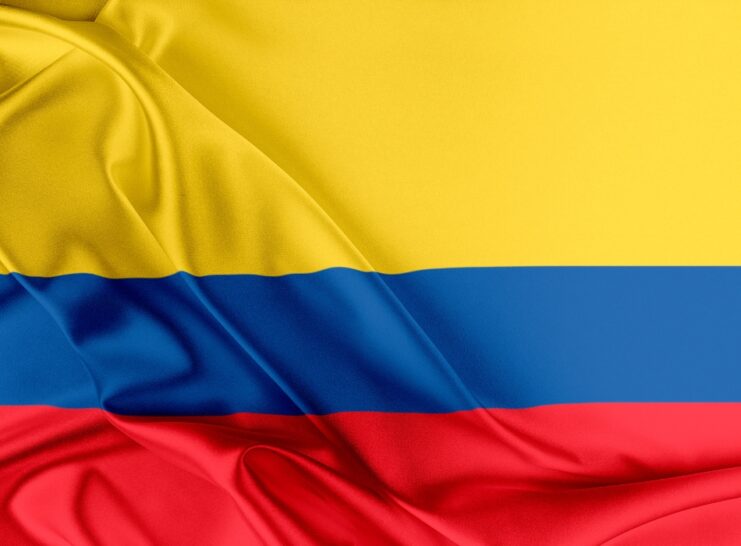
Colombia is a magnificent country located in South America and its flag is composed of three equally-sized horizontal stripes of yellow, blue and red. With its unique combination of colors, it is a representation of the historical, political and cultural identity of the Colombian nation and is a beautiful symbol of its vibrant culture.
The yellow, blue and red of the Colombian flag reflect the values of liberty, equality and fraternity, which are fundamental principles of the nation. Let’s dive deeper into the meaning of the yellow, blue and red stripes in Colombia’s flag.
Description of the flag
It is divided into three horizontal stripes, similar to the French Tricolore. The top stripe is yellow, the middle stripe is blue, and the bottom stripe is red. All three stripes are equal in width and length.
Situated in the center of it as part of the blue stripe is a yellow depiction representing a stylized ICH (Iglesia de Jesus Christo) symbol which serves as an emblem for faith and protection from God. This came into effect after a referendum held in 1991. Before this symbol, there were two versions of it with either an inverted triangle or “llanura” (plains) featuring mountains and the sun.
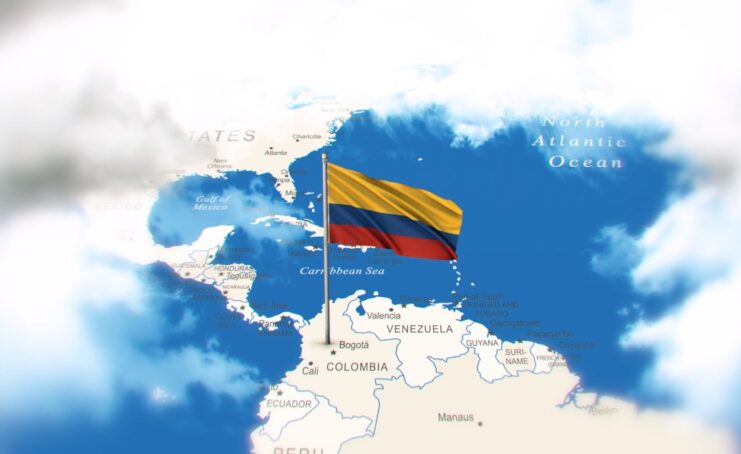
Flag History
Colombia is situated in South America and is bordered by Brazil, Ecuador, Panama, Peru, and Venezuela. The current one was adopted on November 26th, 1861. It was created to honor the civil war between the states of Gran Colombia and New Granada.
The design of the Colombian flag includes three horizontal stripes of equal width – yellow at the top, blue in the middle, and red at the bottom. The yellow stands for sovereignty and justice while the blue represents loyalty, vigilance, perseverance, and justice. The red stripe honors valor, honor and generosity. In each corner of it resides a yellow five-point star which symbolizes both its states’ unity as well as their commitment to freedom for all its citizens.
4. The Democratic Republic of the Congo
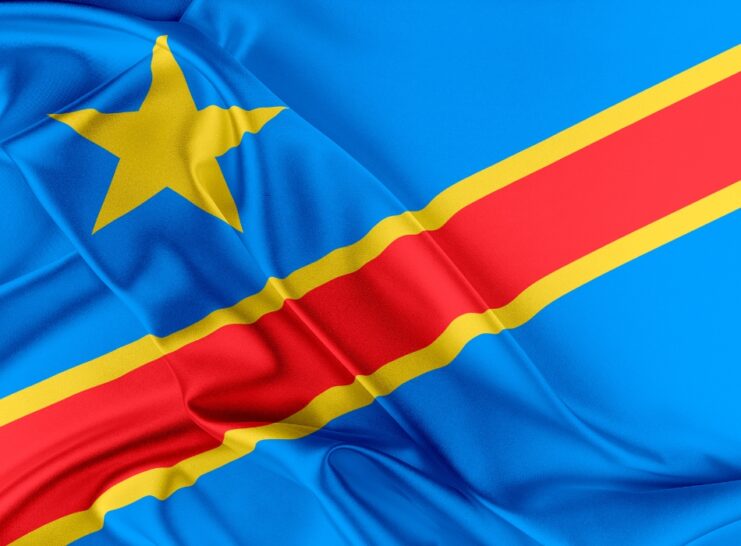
The Democratic Republic of the Congo often referred to as DRC or simply Congo is a country located in Central Africa. It is the second-largest country in the African continent, with a flag featuring yellow, blue and red stripes. It is a symbol of the nation’s pride, and the design of the flag is quite unique, with its vibrant colors.
The Democratic Republic of the Congo has a tricolor flag with yellow, blue and red stripes, which symbolizes national unity. The yellow stripe stands for the countries’ wealth and its history as a colony; the blue is for peace and hope; and the red stands for struggle and blood lost in defense of the nation. It was adopted in 2006 following independence.
It was once used to represent Belgian Congo between 1928-1959, but with a different design. Furthermore, it is an adaptation of the Flag of Tanganyika (a former East African State) with its three horizontal stripes, which derived from those used by Ethiopia during its struggle against Italy’s colonial forces in the late nineteenth century.
Flag History
The Democratic Republic of the Congo’s flag is among the more unique flags of the world. The three bands of color – blue, yellow and red – have been in existence since 1877, when they represented the national independence of an earlier Congo state. The colors are derived from a combination of the blue-white hoist banner and the triple bars on a shield that were part of an earlier design found in old documents.
The current signature design came when it was updated in September 2006 to match its previous 2006b version with a green symbol inside representing sustainable development within a democracy. This also followed a larger overhaul by Former President Joseph Kabila, which gave blue a light shade instead of being identical to both other colors and made it slightly brighter.
Despite its historical significance, this flag did not become official until 21 March 2001 to replace what had been a daily parade version since 1997. This newer version had unique details such as writing both “RÉPUBLIQUE DÉMOCRATIQUE DU CONGO” and “RDC” (both representing the country’s name) down near the center hoist while still showing off those three unmistakable colors at full size and glory across the whole field.
5. Moldova
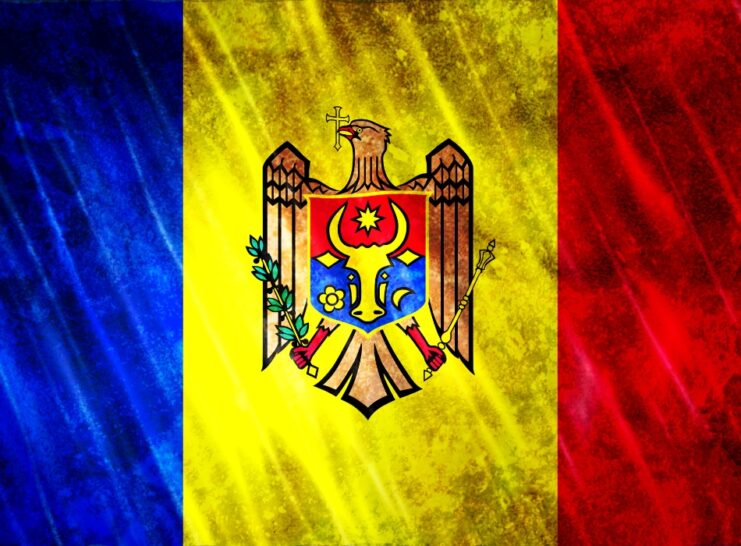
The flag of Moldova is a result of collaboration between Moldovan artists, historians, and politicians. It features a yellow, blue and red tricolor. The yellow symbolizes the sun and a prosperous future, while the blue stands for love, serenity and faith. The red signifies courage and bravery, as well as justice and respect for the law.
The flag was officially adopted in 1990 as a sign of Moldova’s renunciation of Soviet rule.
What does it stand for
It consists of three vertical bands, with blue on the hoist side, yellow in the middle and red on the fly side. This tricolor design is typical of many European nations, as it was first used by the French during the revolution and is similar to those employed today by Croatia and Romania.
At the center of the Moldovan flag is an eagle that holds a shield in its talons. This shield contains a traditional Moldovan village with a church in between two hills that are surmounted by a rising sun. Above this scene are symbols representing Liberty, Justice and Truth: an open book below a cross-topped pole with a Phrygian cap placed atop it.
This powerful symbol has been long associated with Valachia and Bessarabia, which together were incorporated into modern Moldova in 1918. The blue represents liberty; its rays represent progress; while justice and truth are represented by the yellow and red respectively. Together they remind us of what freedom can bring when these values are held dear.
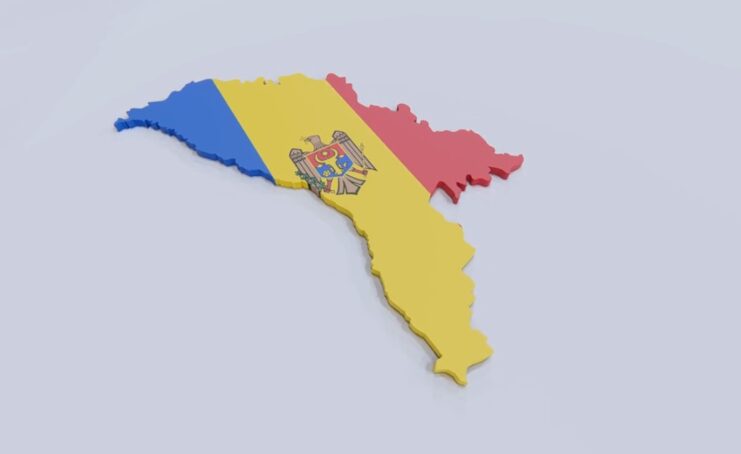
Making of the flag
The flags of Moldova, Romania, Liechtenstein, Mongolia, Chad and Colombia share an important similarity: their flags all feature the three colors of yellow (or gold), blue and red. The origins of this tricolor combination teem with patriotic and cultural significance stretching back centuries.
The flag of Moldova is known to date back to at least 1848 – over two centuries ago – when it featured a red Christian cross against a yellow background. As years passed and other countries adopted similar tricolor designs during the 19th century’s wave of nationalism, the Christian symbol was replaced by symbols like feathers in Andorra’s flag or logos depicting lightning bolts in Colombia’s flag; ultimately modifying their flags to reflect each nation’s particular statehood sensibilities.
As for Moldova’s modern-day tri-color symbolizing Europe’s most eastern self-governing country its overall design remains largely unchanged from 1848: a striping pattern reading from left to right symbolizing blue–yellow – red where each stripe captures portions of both heritage (cultural) and ethics (values) as an independent nation.
6. Mongolia
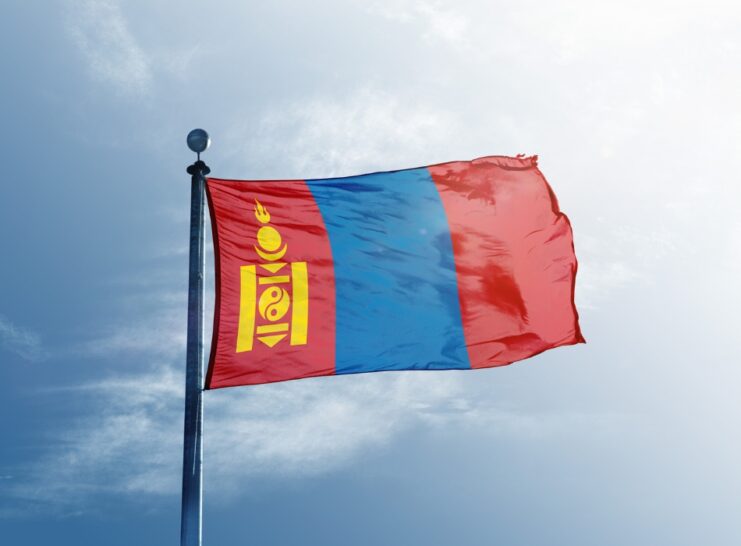
Mongolia has a flag with a yellow, blue and red color palette. Yellow stands for justice, blue stands for bravery, and red stands for prosperity. The stripes also refer to the importance of the past and the future of Mongolia.
Flag Description
The flag of Mongolia consists of three vertical stripes in the colors of yellow, blue, and red. The yellow stripe is on the hoist side and stands for agriculture and prosperity; the blue stripe symbolizes justice, peace, and harmony; finally, the red stripe represents strength and the Mongolian people.
At the center of Mongolia’s flag is a representation of Soyombo, a national symbol that can be both Buddhist and shamanistic in origin. Represented within Soyombo is that sun’s rays represent long life for Mongolia; two triangles stand for strength; two squares represent tranquility and wisdom; flame means passion as well progress. And an arrow pointing up and to the right signifies Mongolia as an independent nation.
Finally, at the very center are representations of a crescent moon (faithfulness) facing upwards (openness) among sweeping lines representing outer space within which there are rising stars to show progress.
Flag History
It was officially adopted on January 12, 1992. It is composed of the traditional colors of red and blue, chosen to represent Mongolia’s development from a farmer’s nation to an industrial one. The yellow represents the country’s nomadic background and the richness of its soil. A famous white khorlo sits in the center of the flag, representing surrounded strength and national unity.
The white silken emblem located in the middle of Mongolia’s flag is known as a Soyombo symbol, which was created by Mongolian monk Zanabazar in 1686. The symbol contains eight elements: fire; sun; moon; two triangular symbols; two facing dragons; a double-edged elephant goad (or pestle); and finally, a trident—all precious objects from Buddhism and ancient Mongol Culture.
The headpiece at the top refers to heaven, with five flame-like elements representing gratitude for mother earth that helps sustain life with her fertility. The celestial symbols underneath stand for loyalty and honesty in personal relationships as well as between political parties in Transylvania Ulaanbaatar (the capital city). Finally, three seeds represent richness or blessings from above or paradise on earth due to wise rule by powerful leaders who were said to have arisen out of flames.
7. Romania
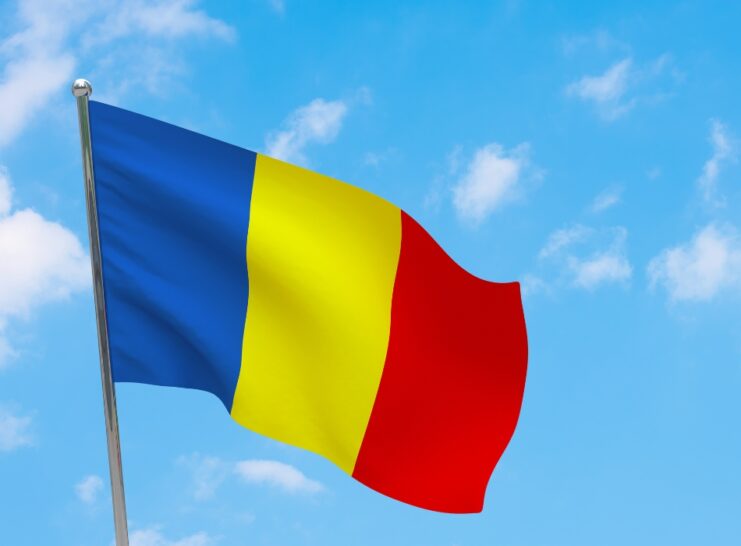
The flag of Romania is a vertical tricolor of blue, yellow, and red. It is the true national flag of Romania, first adopted in 1848. The blue stripe has a width of 1/4 of the flag’s total width, the yellow 2/3, and the red 1/4.
Its design is rooted in the traditional national and peasant costume, and in the French Revolution ideals.
Description of the flag
The national flag of Romania is a tricolor consisting of vertical bands of blue, yellow, and red. This combination is a version of the pan-Slavic colors adopted by many Slavic peoples in the 19th century; it was first used to represent Romania in 1834 and officially adopted for that purpose in the same year. It was later adopted as the main flag of Romania on December 27, 1989 when communism ended in Romania.
The current design features a vertical band of blue on the left side (facing away from the hoist), followed by one yellow bar and then one red bar. The colors are symbolic; blue represents liberty, yellow represents justice and red stands for fraternity. According to tradition, this combination also reflects the presence of three major regions within Romania: Walachia (blue), Moldavia (yellow) and Transylvania (red).
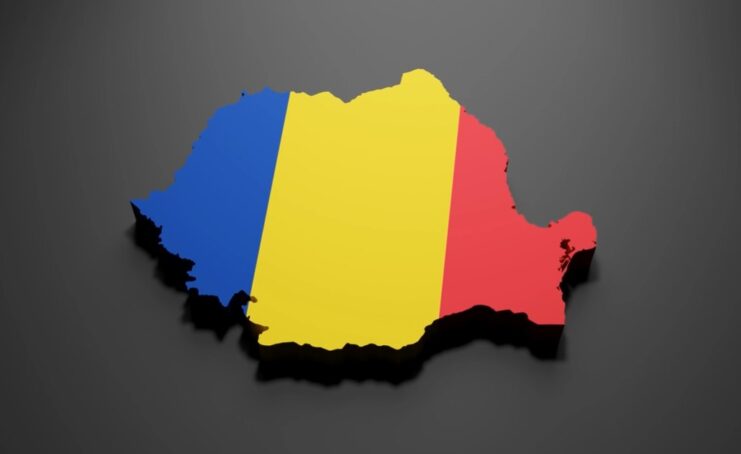
Flag History
The flag of Romania is a tricolor with vertical stripes, colored blue, yellow, and red in the same order. It has been the national ensign since the late 19th century but was officially adopted in 1989 following the overthrow of communism.
The origin of the flag’s colors lies with mid-19th century intellectuals and revolutionaries. The blue stripe was for nationalism, red for liberty and yellow for fraternity—the motto “Libertate, Fraternitate, Natio” (liberty, brotherhood and nation) inscribed at the base of one version. The coat of arms featured on subsequent versions included a golden aquila to represent strength, a sun symbolizing progress and a wreath representing victory in battle.
Throughout much of its modern history Romania adopted different flags associated with different political regimes or ideologies; however this bicolor tricolor has survived throughout all changes. It was first hoisted in 1848 when representatives from Transylvania declared their country’s autonomy and it again flew during two failed revolutions against Ottoman rule in 1855 and 1877.
It became the country’s official ensign upon unification with Moldavia in 1859 until 1862 when it was replaced by the princely blue-yellow-red tricolor flag which continued to fly until 1918 when Bucharest declared union with Transylvania—the slightly amended current 23:1:19 design intended to pay tribute to all three Romanian territories which formed part of Grand Principality until World War II when Romania became occupied by Nazi Germany and Antonescu’s dictatorship stripped other regions of the country while dramatically changed its borders downplaying Romanian minorities abroad or even confiscating their lands contributing toward bitter multinational disputes still carrying on o this day between former allies or neighbors such as Hungary, Serbia whose claim on Vojvodina are still heavily unsettled but have raised as diplomatic issues over recent years all further adding up to broken relationships between communities that should otherwise remain allied—if we look beyond all major historical blunders.
Taking into account past events along these disputes may still haunt so many who remember why this very same tricolour now serves as a symbol depicting hope throughout unity across its people.
8. Liechtenstein
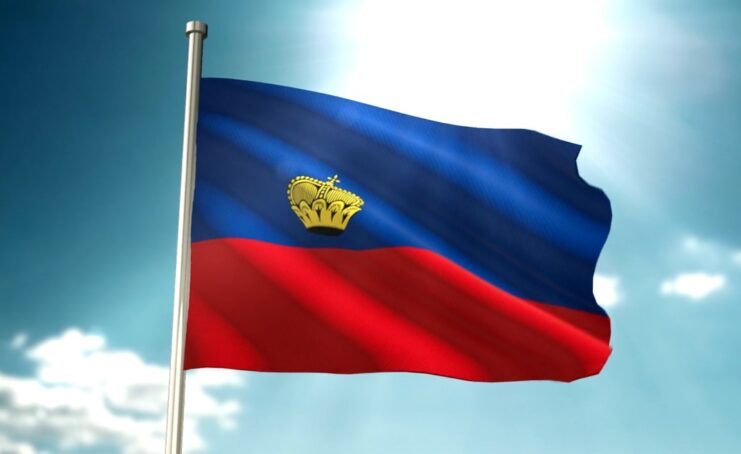
Liechtenstein has one of the most remarkable flags – a bright blue and red background with a thin yellow stripe through the center. It is the only flag that features three colors, blue, yellow and red, in this combination. This combination is used to represent power, peace, and justice — the symbol of the state.
Let’s look further into the history and symbolism of Liechtenstein’s flag.
Flag Description
The Liechtenstein flag is a tricolor horizontal triband featuring yellow, blue and red. The colors of the flag mirror the colors of the House of Liechtenstein, and their coat of arms harkens back to their ancestry in the Middle Ages. In fact, this coat of arms was itself taken from that used by the medieval Austrian-Hungarian Empire.
The colors of Liechtenstein also carry significant symbolism as yellow represents faithfulness and loyalty; red is for strength, courage and bravery; and blue stands for peace, truth and tranquility. The blue stripe is double-width to symbolize its place as being between Austria, who it was closely associated with historically, on one side and Switzerland on the other.
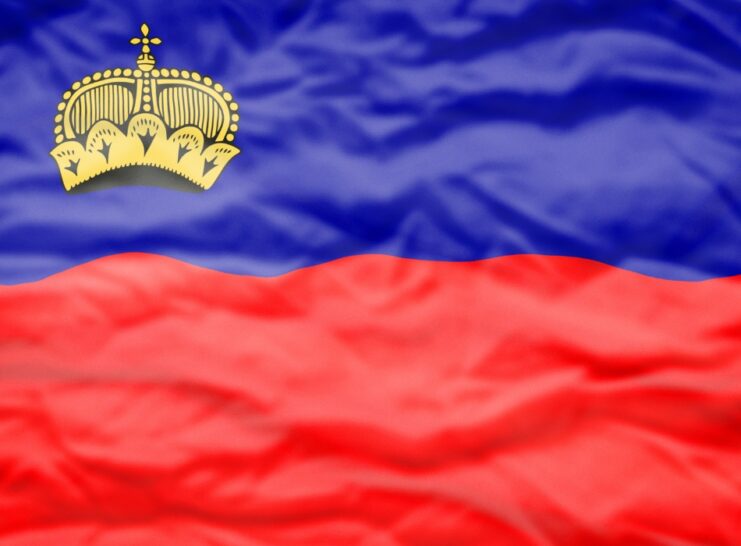
Flag History
The current flag of Liechtenstein was adopted in August of 1921. It is the only national flag to feature a crown, which represents the country’s position as a principality. The colors of the Liechtenstein flag are blue, red, and yellow. The colors have been used on European flags since at least the 12th century, but they have changed in exact meaning and symbolism over time.
The blue and red on it are said to be taken from an old imperial banner of Nassau-Weilburg that flew over Liechtenstein for centuries both before and after its independence. This banner contained two vertical stripes: blue on the left side and red on the right side.
In late 1871, Archduke Johann added a horizontal yellow stripe in between these two colors, making this design nearly identical to the modern one that flies proudly in Liechtenstein today. All three of these colors have been symbols of power and strength throughout much of Europe’s history, so their use together on the current flag pays tribute to Liechtenstein’s strong past.
Conclusion
The combination of the three colors — yellow, blue, and red — is present in a number of flags around the world. Often found on national flags such as Andorra’s as well as that of Chad and Colombia, this iconic set of colors represents various aspects related to a nation’s history. For example, in Romania, it stands for traditional peasants’ clothing, while in Mongolia it is associated with the country’s nomadic culture and customs.
This vibrant combination can also be seen on the flag of the Democratic Republic of Congo which includes representations for its four main ethnic groups. Meanwhile, Liechtenstein and Moldova employ a tricolor set-up featuring striped banners mixing both yellow, blue and red hues.
As can be seen from this array of flags from countries across the world, this vibrant trio from the color palette holds a special place in many cultures. Representing aspects such as tradition, nature and artistry; yellow, blue and red will continue to make eye-catching appearances for many years to come.

